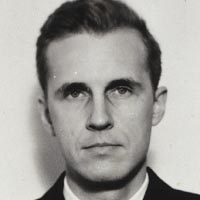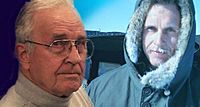Harley D. Nygren facts for kids
Quick facts for kids
Harley D. Nygren
|
|
|---|---|
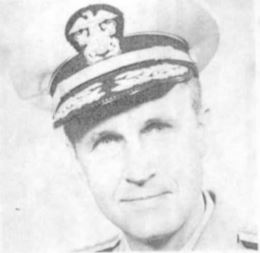 |
|
| Birth name | Harley Dean Nygren |
| Born | December 12, 1924 Seattle, Washington |
| Died | (aged 94) |
| Place of burial |
Indiantown Gap National Cemetery, East Hanover Township, Pennsylvania
|
| Allegiance | United States of America |
| Service/ |
United States Naval Reserve (1942–1947) |
| Rank | |
| Commands held | USC&GS Surveyor (OSS 32) NOAA Commissioned Officer Corps |
| Battles/wars | World War II Cold War |
| Awards | |
Rear Admiral Harley Dean Nygren (December 12, 1924 – November 17, 2019) was an American military officer. He served in several important U.S. government organizations. These included the United States Coast and Geodetic Survey Corps, the Environmental Science Services Administration Corps (ESSA Corps), and the National Oceanic and Atmospheric Administration Commissioned Officer Corps (NOAA Corps). He was the very first Director of the NOAA Corps.
During his career, Nygren worked on many mapping projects on land and at sea. He traveled to places as far north as the Arctic and as far south as Antarctica. He also helped with important discussions that led to the creation of ESSA and later, the National Oceanic and Atmospheric Administration (NOAA).
Contents
Early Life and Military Service
Growing Up in Washington
Harley D. Nygren was born in Seattle, Washington, in 1924. He started working for the U.S. Government as a laborer. He worked in a United States Army warehouse.
When the United States entered World War II after the attack on Pearl Harbor in 1941, Nygren joined the U.S. Naval Reserve in 1942. He was only 17 years old. The Navy sent him to the University of Washington. He earned a Bachelor of Science degree in 1945. After graduating, he became an ensign in the Naval Reserve.
In 1946, Nygren was a damage control officer on the destroyer USS Hughes (DD-410). This ship was being prepared to be a target for atomic bomb tests. These tests, called Operation Crossroads, happened at Bikini Atoll. After this, he returned to Seattle. He continued his studies at the University of Washington. In 1947, he earned another Bachelor of Science degree, this time in mechanical engineering.
Career in Science and Surveying
Working with the Coast and Geodetic Survey
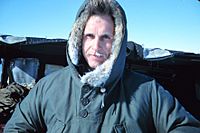
In September 1947, Nygren left the Naval Reserve. He began working for the United States Coast and Geodetic Survey as a civilian officer. In 1948, he became an ensign in the United States Coast and Geodetic Survey Corps. He was assigned to the survey ship USC&GS Explorer (OSS 28). For six months, he surveyed the Aleutian Islands.
From 1949 to 1951, Nygren worked with the Coast and Geodetic Survey's Arctic Field Party. They surveyed the Alaska North Slope. This team created the first accurate maps of this area. As a lieutenant (junior grade), Nygren used this knowledge to guide United States Navy ships. He helped them travel safely along the Alaska North Slope.
In 1952, Nygren became the executive officer of the ship USC&GS Hodgson (CSS 26). They worked in Oregon and Puget Sound in Washington. In 1953, he moved to the ship USC&GS Pathfinder (OSS 30). He helped map areas in the Aleutian Islands, Bering Sea, and Cook Inlet. By the end of 1953, he was Pathfinder's operations officer.
From 1954 to 1957, Nygren led a team that measured gravity around the world. In 1957, he returned to Pathfinder as operations officer. They worked in the Bering Sea and along the coast of Alaska. In 1960, he studied oceanography at the University of Washington. He even took a research trip to the Arctic Ocean. After that, he served on the ship USC&GS Pioneer (OSS 31). This ship discovered many seamounts (underwater mountains) in the North Pacific.
In 1962, Nygren was sent to Antarctica. He worked with British research ships. He visited many bases and islands there. He then returned to the U.S. and worked on the Coast and Geodetic Survey's planning staff. He helped create a new government science organization called the Environmental Science Services Administration (ESSA).
Leading the ESSA Corps
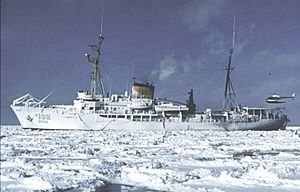
On July 13, 1965, ESSA was formed. The Coast and Geodetic Survey became part of ESSA. Its officers became part of the new Environmental Science Services Administration Corps (ESSA Corps). Nygren became an officer in this new corps. He also became a Deputy Director in ESSA.
In August 1966, Nygren chose to take a lower rank so he could go back to sea. He became the executive officer of the ship USC&GS Surveyor (OSS 32). They worked in the North Pacific, Bering Sea, and Aleutian Islands. In 1968, Nygren became the commanding officer of Surveyor. Under his command, the ship did important geophysical surveys. These surveys helped scientists understand the continental shelf. He was promoted to captain while commanding Surveyor.
In October 1968, Nygren became a rear admiral. He helped plan the creation of the new National Oceanic and Atmospheric Administration (NOAA).
First Director of the NOAA Corps
On October 3, 1970, NOAA was created. The ESSA Corps became the new National Oceanic and Atmospheric Administration Commissioned Officer Corps (NOAA Corps). Nygren became a NOAA Corps officer. On October 27, 1970, he became the Acting Director of the NOAA Corps. In February 1971, President Richard Nixon officially appointed him. This made him the first Director of the NOAA Corps.
As NOAA Corps director, Nygren worked on many projects. He helped with efforts to extend the shipping season on the Great Lakes. He also worked on issues related to U.S. control of the continental shelf. He was involved in discussions about oil spills and oceanography. His duties took him to Alaska, Antarctica, and international meetings in Monaco and Switzerland.
In 1972, under Nygren's leadership, the NOAA Corps made history. It became the first of the seven uniformed services of the United States to recruit women on the same basis as men. He also expanded the NOAA Corps training program. He arranged for it to be held at the United States Merchant Marine Academy in Kings Point, New York.
After more than ten years as NOAA Corps director, Nygren retired on January 1, 1981.
Life After Service
Nygren was a talented photographer throughout his career. Many of his photographs are part of the NOAA Photo Library. He was also a member of the Marine Technology Society.
Awards and Recognition
Nygren received several important awards for his service:
 Department of Commerce Gold Medal, 1975
Department of Commerce Gold Medal, 1975 Department of Commerce Bronze Medal
Department of Commerce Bronze Medal Karo Award, 1961
Karo Award, 1961 NOAA Unit Citation Award
NOAA Unit Citation Award
In 1975, Nygren received the Department of Commerce Gold Medal. He also received the Society of American Military Engineers Karo Award in 1961. Other honors included the Department of Commerce Bronze Medal and a NOAA Unit Citation Award. He also received commendations from the United States Navy and the United States Air Force.
Death and Legacy
Nygren passed away on November 17, 2019, at the age of 94. He was buried on December 6, 2019, at Indiantown Gap National Cemetery in East Hanover Township, Pennsylvania.
Two places are named after Harley D. Nygren:
- Mount Nygren is a mountain on Kyiv Peninsula in Antarctica. It is located at 65°9′S 63°48′W / 65.150°S 63.800°W.
- Nygren Canyon is an underwater canyon in the Atlantic Ocean. It is about 150 miles off Cape Cod, Massachusetts, at 40°39′N 66°30′W / 40.650°N 66.500°W.


